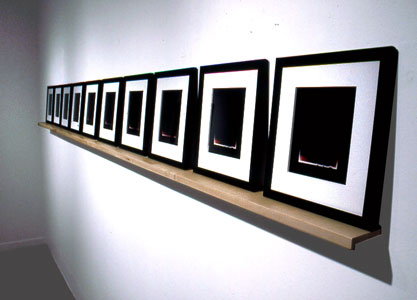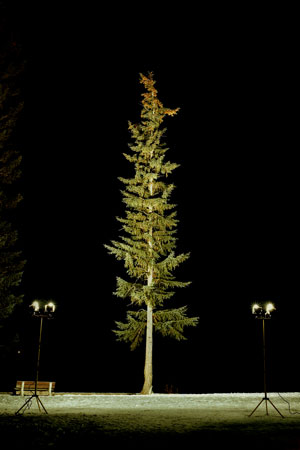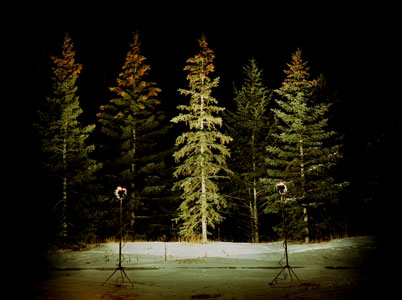Andrew Wright: Mises-en-scene
Canadian Art, Vol. 19, No. 4
Winter 2002
By Anna-Marie Larsen
The term mise-en-scène refers to the scene set on stage or before a camera. By naming his solo exhibition at Toronto's Red Head Gallery with the term, Andrew Wright overtly links his work to the theatrical and cinematic. Wright left graduate school five years ago and the work he has delivered since––photographs, prints, videos and installations––speaks with evident promise. Indeed, one way to understand "Mises-en-scène" is to see the work as a summation or synopsis of the ideas and themes he has enunciated to date, like his embrace of formal concerns––probing how a camera's lens works, or asking what happens to film when you muss with its chemistry. Other questions he raises consider mechanics, light and space; as well as how these terms are defined and how we perceive ourselves in relation to them.
The three series of colour photographs in the exhibition are, at a glance, dissimilar. Untitled Aeroplanes (2001) is a grid of six photographs, each presenting a square of pristine blue sky interrupted only by a tiny airplane. In them Wright investigates how the slightest change of camera angle or time alters how we perceive a site.
A second set of colour images, titled Douglas Fir (2002), uses tungsten lighting to illuminate trees at night in Banff, Alberta. On one level the pictures address the artificiality of what we call wilderness in Canada's national parks, implying that the sites have more in common with museum practices of selectively presenting, preserving and interpreting than with anything natural. Issues relating to the conventions of landscape photography and studio portraiture are also suggested.
The third set, Box of Ten (1999–2002), shows a series of psychedelic light bursts on photographic paper. Wright found stale-dated film with tiny holes in its packaging and left it on a windowsill to gradually expose over two and a half years, essentially using the found film as its own pin–hole camera. Visually these images are the least compelling ones in the show. However, they best represent Wright's concerns with experimentation and process, and remind us of the (essentially) crude technologies that enable photography.
Scene (2002) is a stand-alone image and an anomaly in the context of the series photos. It is a shot of two tungsten lights on facing poles. They illuminate a dense snowfall and lend incidental clarity to the ground around them. In essence, however, what is lit is empty space; it is a picture of lights lighting each other. This doubled illumination captures Wright's fascination with how a camera makes a static record of the fluidity of light and space. It underscores his attention--which, if we are attentive, we notice running through every work in the exhibition--to scenes and moments that might be thought inconsequential, and asserts the pro-filmic approach of his work. Look, Wright seems to say. Just look.





